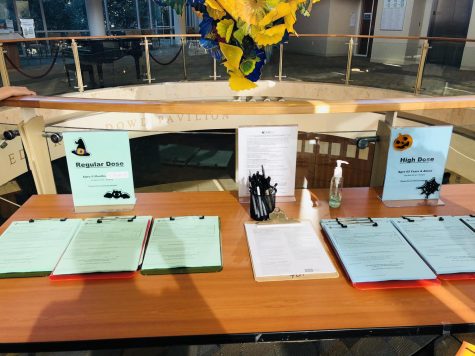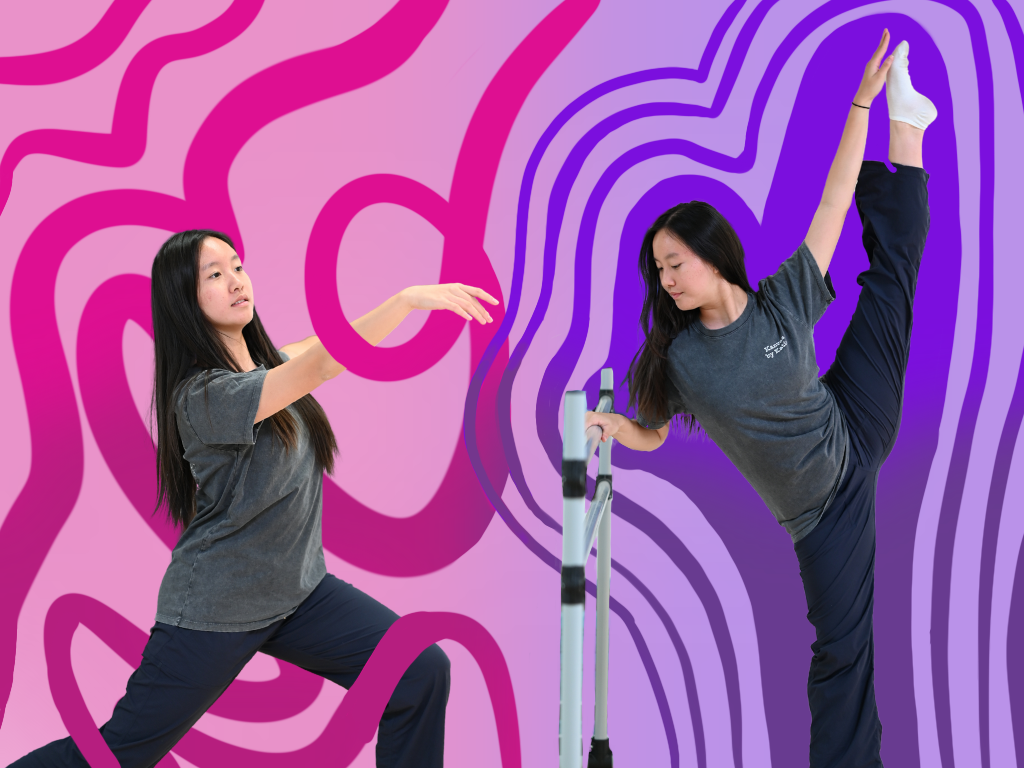Staying Healthy with Saloni: Flu Shot Season
Patients wait at the check-in counter. The flu season typically starts in December, peaks in February and ends in April.
November 17, 2018
“Hey Alexa, open Flu Doctor, ” I said. Did you know that the app Flu Doctor has tons of information available on flu to promote flu vaccines using smart speakers and home-based AI? I definitely didn’t.
It’s flu season again, and I’m trying to beat the long lines at my doctor’s office.
Every year, I reluctantly take the flu shot. It’s not that I am squeamish about the needles, but I have an adverse reaction to the flu shot. Even though the nurse assures me that the shot is quick and will only hurt for a second, the reality is that my arm swells up and pains for two full days.
When I was younger, I would take the shot on my right arm and use it as a pretext not to do homework, but my mom soon figured it out, and the following year she made sure that I took the flu shot on my left arm.
The 1918-19 influenza epidemic or the Spanish flu which claimed approximately 50 million deaths worldwide drove a lot of research on the influenza virus and the development of the first flu vaccine in 1938. The flu vaccine demand has grown since 2009 when a new strain of H1N1 was discovered. According to Centers for Disease Control, the severe 2017-18 flu season resulted in 80,000 deaths in the U.S including 180 children.
There has been a lot of buzz about developing a universal flu vaccine, a shot to be taken once in five or 10 years which would protect against all virus variants and replace an annual flu shot. However, this is unlikely as the recent budget cuts have only allocated $100 million this year for
the development of universal flu vaccine versus the needed $1 billion in research funding for five to seven years.
Upper school nurse Clare Elchert concedes that there are many myths surrounding flu shots and a common misperception that flu shots make you sick.

A table presents forms for two different flu vaccines. One is for the regular dose, suited for ages 6 months to 64 years; the other is for the high dose, suited for ages 65 years and above.
Yes, we all know that the flu shot is not 100 percent effective, and it cannot guarantee that you will not catch the flu. Most of the years, it’s a hit or a miss, and accordingly we will either have a mild or a severe flu season. In fact, the flu shot is effective only 60 percent of the time.
Yes, most teens think that the flu is hardly fatal among teens, yet some effectiveness is better than none. The flu can actually make you really sick with fever, body aches, weakness and it can exacerbate chronic health conditions like asthma.
Let’s be real, in a high school environment, we all want to avoid missing school days and dealing with missed schoolwork and assignments. With the flu shot however, even if you do catch the flu, your symptoms will be less severe.
“The flu shot helps with the immunity to help protect you during the flu season and to keep you in classes and up-to-date with your school work without having absences,” Elchert said.
There are actually quite a few challenges with creating the flu vaccine itself. There are two types of flu vaccines available – Trivalent flu vaccines and Quadrivalent flu vaccines. Trivalent flu vaccines contain three components of flu strains – H1N1, H3N2, and one influenza B strain. Quadrivalent flu vaccines protect against same three strains as the Trivalent and an additional influenza B strain.
One of the biggest challenges is deciding in advance at around February which virus variants to include in the manufacturing of the flu vaccine. The effectiveness of the flu vaccine will depend on how close the variants that cause the outbreak are to the variants included in the vaccine. The 2018-19 flu shot is slightly different from last year’s shot – although the H1N1 component is same as last year, the H3N2 component and influenza B component is different from last year’s shot.
To add to the complexity, the effectiveness of a flu vaccine fades by 20 percent each month after the shot is administered.
Dr. Michael Osterholm, director of the Center of Infectious Disease Research and Policy at the University of Minnesota, spoke to the New York Times about the best time to take the flu virus shot.
“Since 95 percent of flu outbreaks start in mid-December, it’s best to get the flu shot in early to mid-November,” he said.
The flu season typically starts in December, peaks in February and ends in April. I can’t wait to share this with my mom since she usually drags me to the clinic the first week the flu shots are released in mid-late September.
In addition to the flu shot, follow the three “C’s” of healthy habits: cover, contain and clean to prevent the spread of germs. I like using hand sanitizer as a disinfectant but research shows that washing hands with soap and water is more effective than using hand sanitizers.
In addition to drinking plenty of water and eating fruits and vegetables, Elchert stresses the importance of sleep, non-caffeinated drinks and non-junk food in adolescents.
“Research says adolescents need nine hours of sleep,” she said. “When I mention this to Harker students, their eyes glaze over, and they think I am crazy. You should aim for eight hours of sleep.”
Until the universal flu shot becomes a reality, even though I will continue to whine, I know I will force myself to take a flu shot every year as a responsibility towards both myself and the people around me.


















![“[Building nerf blasters] became this outlet of creativity for me that hasn't been matched by anything else. The process [of] making a build complete to your desire is such a painstakingly difficult process, but I've had to learn from [the skills needed from] soldering to proper painting. There's so many different options for everything, if you think about it, it exists. The best part is [that] if it doesn't exist, you can build it yourself," Ishaan Parate said.](https://harkeraquila.com/wp-content/uploads/2022/08/DSC_8149-900x604.jpg)




![“When I came into high school, I was ready to be a follower. But DECA was a game changer for me. It helped me overcome my fear of public speaking, and it's played such a major role in who I've become today. To be able to successfully lead a chapter of 150 students, an officer team and be one of the upperclassmen I once really admired is something I'm [really] proud of,” Anvitha Tummala ('21) said.](https://harkeraquila.com/wp-content/uploads/2021/07/Screen-Shot-2021-07-25-at-9.50.05-AM-900x594.png)







![“I think getting up in the morning and having a sense of purpose [is exciting]. I think without a certain amount of drive, life is kind of obsolete and mundane, and I think having that every single day is what makes each day unique and kind of makes life exciting,” Neymika Jain (12) said.](https://harkeraquila.com/wp-content/uploads/2017/06/Screen-Shot-2017-06-03-at-4.54.16-PM.png)








![“My slogan is ‘slow feet, don’t eat, and I’m hungry.’ You need to run fast to get where you are–you aren't going to get those championships if you aren't fast,” Angel Cervantes (12) said. “I want to do well in school on my tests and in track and win championships for my team. I live by that, [and] I can do that anywhere: in the classroom or on the field.”](https://harkeraquila.com/wp-content/uploads/2018/06/DSC5146-900x601.jpg)
![“[Volleyball has] taught me how to fall correctly, and another thing it taught is that you don’t have to be the best at something to be good at it. If you just hit the ball in a smart way, then it still scores points and you’re good at it. You could be a background player and still make a much bigger impact on the team than you would think,” Anya Gert (’20) said.](https://harkeraquila.com/wp-content/uploads/2020/06/AnnaGert_JinTuan_HoHPhotoEdited-600x900.jpeg)

![“I'm not nearly there yet, but [my confidence has] definitely been getting better since I was pretty shy and timid coming into Harker my freshman year. I know that there's a lot of people that are really confident in what they do, and I really admire them. Everyone's so driven and that has really pushed me to kind of try to find my own place in high school and be more confident,” Alyssa Huang (’20) said.](https://harkeraquila.com/wp-content/uploads/2020/06/AlyssaHuang_EmilyChen_HoHPhoto-900x749.jpeg)















